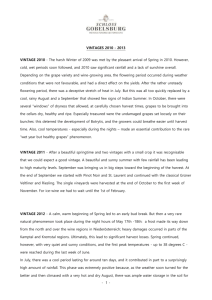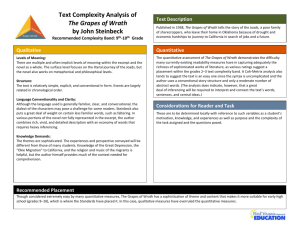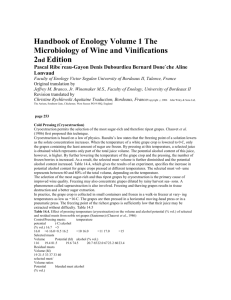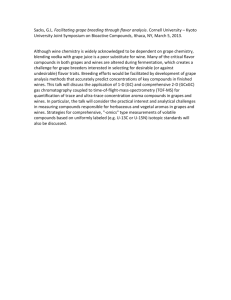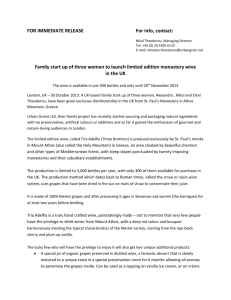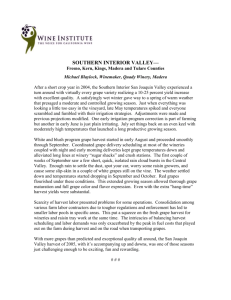Table Grape Profile Value Chain
advertisement
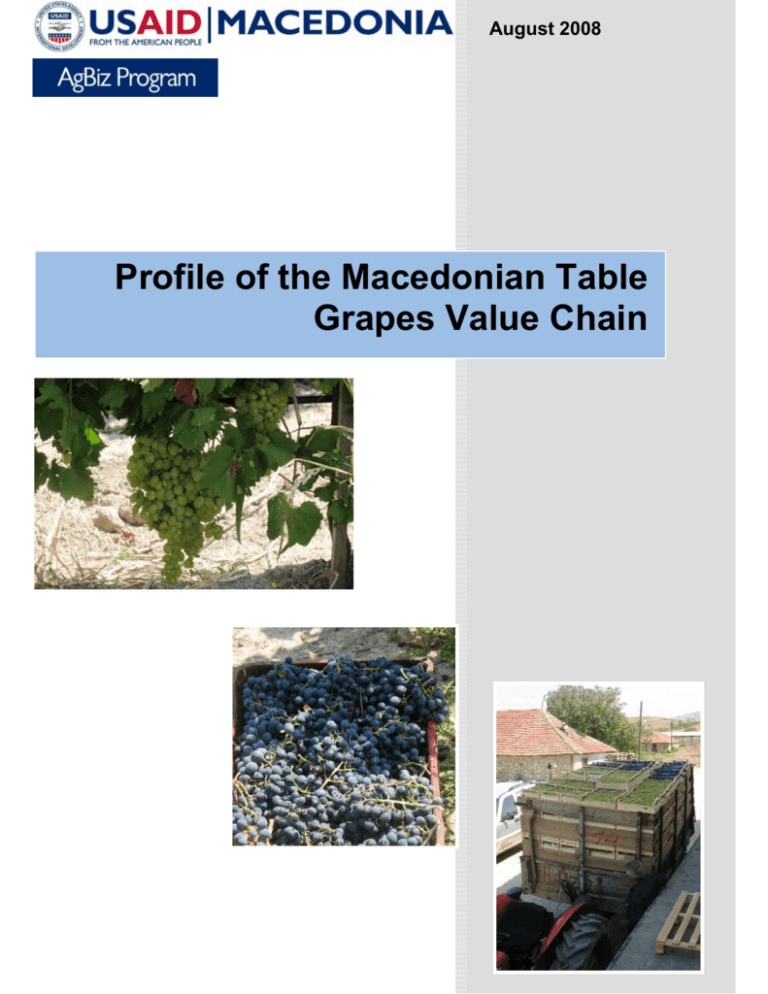
August 2008 Profile of the Macedonian Table Grapes Value Chain Disclaimer This Profile was produced for review by the United States Agency for International Development. It was prepared by Macedonian Consulting Group for the USAID’s AgBiz Program. The author’s views neither expressed in this Profile do nor necessarily reflect the views of the Unites States Agency for International Development or the United States Government. TABLE OF CONTENTS 1. 2. 3. 4. INTRODUCTION ............................................................................................................. 1 OBJECTIVES AND SCOPE ............................................................................................ 1 WORKING METHODOLOGY ......................................................................................... 2 RESULTS ON FINDINGS ............................................................................................... 2 4.1 Description of current situation with vineyards ........................................................ 2 4.2 Geographical distribution of the vineyards .............................................................. 4 4.3 Status of Macedonian Vineyards ............................................................................. 7 4.4 Governmental support ............................................................................................. 7 4.5 Grape production in Macedonia .............................................................................. 8 4.6 Table grape value chain stakeholders ..................................................................... 9 4.6.1 Individual agricultural households ................................................................... 9 4.6.2 Agricultural enterprises .................................................................................. 10 4.6.3 Packers/exporters.......................................................................................... 14 4.7 Export of the Macedonian table grapes ................................................................. 15 4.8 SWOT analysis of the table grapes industry ......................................................... 17 5. FINAL REMARKS AND RECOMMENDATIONS .......................................................... 18 LIST OF TABLES Table 1: Total area under vineyards in Macedonia 2003 – 2007 ............................................ 3 Table 2: Ownership of the vineyards 2005-2007 .................................................................... 3 Table 3: Table grapes and wine grapes vineyards in 2007..................................................... 4 Table 4: Age composition of the vineyards in Macedonia ....................................................... 7 Table 5: Production of grapes 2003-2007 ............................................................................... 8 Table 6: Grape production by production groups 2006-2007.................................................. 9 Table 7: Individual households’ vineyards in 2007.................................................................. 9 Table 8: Associations involved in grape production .............................................................. 10 Table 9: Agriculture enterprises’ vineyards in 2007 .............................................................. 11 Table 10: Table grape vineyards by agricultural enterprises in 2007.................................... 11 Table 11: Table grapes production by selected enterprises in 2007..................................... 12 Table 12: Full time and seasonal labor engaged by the enterprises in 2007 ........................ 13 Table 13: Implemented food related standards by interviewed table grape enterprises ....... 13 Table 14: Table grapes purchased by the interviewed packers/exporters in 2007 ............... 14 Table 15: Number of exporters of table grapes in 2007 ........................................................ 15 Table 16: Implemented food related standards by interviewed table grape exporters .......... 15 Table 17: Export of table grapes from Macedonia 2005-2007 .............................................. 16 Table 18: Average values of the exported table grapes 2005-2007 ..................................... 16 LIST OF PICTURES Picture 1: Geographical spread of the vineyards in Macedonia .............................................. 4 Picture 2: Distribution of the vineyards according to statistical regions .................................. 6 LIST OF ANNEXES ANNEX 1: Export of the table grapes per country, volume and value 2005-2007 ................ 19 ANNEX 2: List of interviewed companies.............................................................................. 21 Study Report Profile of the Macedonian Table Grapes Industry 1. INTRODUCTION The activity titled “Profile of the Macedonian Table Grapes Industry” was conducted on behalf of AgBiz program. AgBiz program is funded by USAID and implemented by ARD, Inc. The goal of the four-year AgBiz program is to increase economic growth in Macedonia through expanded, environmentally sustainable production and sales of value-added agricultural products by enabling producers and processors to compete regionally and globally. This will produce greater incomes for agricultural processors and producers, and ultimately higher revenues for government. AgBiz has the primary objective of stimulating the sustainable growth of Macedonian Agribusinesses participating in value chains with good potential in export markets. Another AgBiz objective is to provide support for improved competitiveness and sustainable development of selected value chains through activities that are based on accurate information about these value chains. 2. OBJECTIVES AND SCOPE The table grape industry plays a very important role in Macedonian agribusiness since a large proportion of the output is said to be sold on export markets. Detailed information on the quantities and type of export markets in not available or very sketchy. The value chain needs a survey that provides in-depth information related to its present product and sales performance. This survey could then be utilized as input for developing future plans for individual companies or the value chain as a whole. This survey will utilize a recognized approach to profiling value chains in the country. A questionnaire will be developed and applied that will allow the survey to achieve the overall objectives of: • • • • • • • • Research and analyze the production figures and export performance of the table grape value chain; Research and analyze historical export volumes and values and the primary destination markets to establish export trends; Gather and analyze relevant export statistical data; Conduct a survey of value chain participants; Collate and analyze all data; Prepare a comprehensive data base on table grape producers, traders, and packers in RM; Profile the important types of participants in the value chain and their numbers and comparative importance; Use the participant interviews to a) identify and profile the competition in the regional and EU markets, and to compare the advantages and disadvantages of Macedonian table grapes in current significant export markets b) identify of key opportunities and threats to the strong and sustainable growth of Macedonian table grape exports; and c) identify projects and activities that AgBiz could design and implement that would help value chain participants capitalize on high priority opportunities and avoid key threats; Profile of the Macedonian Table Grapes Industry 1 Study Report • • • 3. Compile and analyze information related to the number of full-time employees and seasonal labor engaged by the industry; Analyze all findings and develop conclusions into a comprehensive report; and Prepare a workshop on findings and make the findings available to interested parties WORKING METHODOLOGY The project was carried out during June - August 2008 and was consisted of the following phases: I Preparatory work Develop an updated data base of table grape producers, traders and packers II Desk research Information collection (directories, databases, statistics) III Export Data collection and analysis Acquire historical export data, including for 2007, and analyze by tariff numbers IV Questionnaire development, testing of questionnaire and final report outline approval V Field Research Contract, visit and interview key companies VI Collating and analysis Data entry and analysis VII Oral presentation of the report VIII Final report writing, review and submission IX Workshop including key value chain participants 4. RESULTS ON FINDINGS 4.1 Description of current situation with vineyards Viticulture is one of the most important sectors of Macedonian agriculture with wine being a significant export commodity. The combined grape and wine production contributes around 17-20 percent to the agricultural Gross Domestic Product. Wine holds the first position in the export of beverages, and is the second most important product after tobacco in terms of export value among agricultural products. In 2007, according to Agricultural census conducted by the State Statistical Office (SSO), vineyards bearing grapes are represented on 24,584 ha. When compared to Profile of the Macedonian Table Grapes Industry 2 Study Report the previous year, there is a slight increase of 318 ha, but is 460 ha less when compared to total area under vineyards in 2005. More details related to the total areas under vineyards for the period 2003-2007 is presented in the following table: Table 1: Total area under vineyards in Macedonia 2003 – 2007 Year Vineyards in ha Increase in % (compared to the previous year) 2003 25,692 - 2004 24,777 -3.6 2005 25,044 + 1.1 2006 24,266 - 3.1 2007 24,584 + 1.3 Source: SSO, Agricultural census 2007 Companies and other forms of legal entities involved in the wine sector have direct ownership of 30% of the total area under vine, the remaining being held by individual agricultural households. Table 2: Ownership of the vineyards 2005-2007 Year Total area In ha 2005 2006 2007 25,044 24,266 24,584 Agricultural Agricultural Individual Individual Enterprises Enterprises households households in ha in % In ha In % 7,453 29.8 % 17,591 70.2 % 7,521 30.1 % 16,745 69.9 % 7,424 30.2 % 17,160 69.8 % Source: SSO, Agricultural census 2007 Although the table from above clearly indicates the high portion of individual households in the total area under vineyards, the situation is very much different when table grapes and wine grapes vineyards are separately analyzed. In 2007, wine grapes vineyards reached 21,412 ha or 87.1 % from the total, while table grapes vineyards were represented with 3,172 ha or 12.9 % from the total. Out of the total table grapes vineyards, 1,726 ha or 54.4 % were in a possession of agricultural enterprises, while the rest of 1,446 ha or 45.6 % were owned by individual households, which indicates higher concentration and size of table grapes vineyards in the country, due to the fact that 56 enterprises and 49,308 individual households reported vineyards in 2007. More details are provided in the following table. Profile of the Macedonian Table Grapes Industry 3 Study Report Table 3: Table grapes and wine grapes vineyards in 2007 Category Individual sector Agricultural enterprises Total: Total area under vineyards in ha 17,160 In % 69.8 % Wine grapes vineyards in ha 15,714 7,424 30.2 % 24,584 100 % In % 73.4 % Table grapes vineyards in ha 1,446 In % 45.6 % 5,698 26.6 % 1,726 54.4 % 21,412 100 % 3,172 100 % Source: Agricultural census 2007 4.2 Geographical distribution of the vineyards There are three vine-growing regions in Macedonia. The main region (the central region) which encompasses 83 percent of the production is the Vardar region (Povardarie), followed by the Pelagonija-Polog region (the western region covering 13 percent of the production) and the Pcinja-Osogovo region (the eastern region covering about 4 percent)1. These three regions are divided into 16 wine growing sub-regions (or vinogorje). Production in the different vine-growing regions and sub-regions is largely unbalanced. The Tikves sub-region is the main production area of grapes and wine, followed by Gevgelija-Valandovo, Skopje, Veles and Strumica-Radovis sub-regions. Picture 1: Geographical spread of the vineyards in Macedonia Povardarje Region PcinjaOsogovo Region Pelagonija -Polog Region 1 Annual agricultural report 2006 Profile of the Macedonian Table Grapes Industry 4 Study Report The agricultural census, conducted in 2007, presents the distribution of the vineyards according to the statistical regions and gives more accurate details related to the size of the vineyards in different regions. According to this source, the Vardar region accounts for 48.3 % of all vineyards in the country or 11,877 ha, followed by SouthEast region with 20.3 % or 5,000 ha. The rest of 31.4 % or 7,707 ha are located in the other 6 statistical regions, as presented in the following picture: Profile of the Macedonian Table Grapes Industry 5 Study Report Picture 2: Distribution of the vineyards according to statistical regions Source: Agricultural census 2007 Profile of the Macedonian Table Grapes Industry 6 Study Report 4.3 Status of Macedonian Vineyards Generally vineyards have suffered from longstanding under-investment in Macedonia. Until 1980, the financial situation of the Agro-Kombinats was more or less positive and there were regular investments for the uprooting of old plantations and vineyards renewal. The same happened in private vineyards as their grape production was sold to the public wine enterprises. The period from 1980 till 1990 was slightly critical from a financial point of view, but it was after the declaration of independence, and it was a period when the level of investment dropped dramatically. In the last decade several companies and private entrepreneurs operating in agriculture but also in other economic sectors started investing in vineyards and wine production. That’s why in some of the most suitable vineyard areas, particularly in the favorable soils and climatic conditions of Tikves and Gevgelija-Valandovo Vinogorje, vineyards have been significantly renewed. In these areas, grape production is now expanding also in the smallholder sector. According to the available data, majority of the vineyards (about 61 %) are more than 15 years old. Among these, around 10 thousand ha (or 38 %) are at the end of their productive life and need to be urgently uprooted and replanted in order to obtain good quantitative and qualitative production. Table 4: Age composition of the vineyards in Macedonia Age range % of total area <5 8% 5-10 14 % 10-15 17 % 15-20 23 % 20-25 18 % > 25 20% Source: Faculty of Agriculture Food and Science – VMMS Report October 2006) 4.4 Governmental support Understanding the overall negative trends within the agricultural sector, increase of the trading deficit, etc., the Government of the R. Macedonia (after the elections held in 2006) decided to significantly increase the budget for direct support of the Macedonian agribusiness. In the grape production sub sector, the objectives of the supporting activities were to stop the decline of the areas under vineyards, to stimulate development of new plantations and thus to change the negative age structure of the vineyards, and to subsidize farmers that would deliver the wine grapes to the wineries. Also, in order to break up the monopolistic position of the domestic wineries, the Government allowed free exports of wine grapes to export markets. According to the annual budgets for support of the agriculture (prepared by the Ministry of Agriculture, Forestry and Water Economy – MAFWE) the level of subsidies for raising of new vineyards increased from 45,000 MKD/ha or 1,125 $ US2 in 2006 to 120,000 MKD/ha or 3,000 $ US in 2008. According to the plans of MAFWE this amount should increase to 135,000 MKD/ha or 3,375 $ US in 2009 and should additionally encourage individuals and/or enterprises to invest in new vineyards (according to the calculations of MAFWE one ha of new vineyards costs approximately 10,800 $ US) . Exports of table grapes, wine grapes, wine or any other 2 1 $ US = 40 MKD Profile of the Macedonian Table Grapes Industry 7 Study Report agricultural product are not financially supported. Apart from the above mentioned, it should be stated that wine and grapes sub sector is among 4 selected sub sectors eligible for IPARD support, which should additionally improve the performances and competitiveness of the same. Also, it should be mentioned that there is an on-going Vineyard Monitoring and Management System (VMMS), funded by the European Union via the European Agency for Reconstruction (EAR) which, once completed, should provide more detailed picture about the sub sector. Yet, the cadastre will encompass only wine grape production and wine grape vineyards. The cadastre is expected to be finalized during the first half of 2009. 4.5 Grape production in Macedonia The territory of Macedonia should be included in the C III b wine-growing zone (see annex III of EC Reg. 1493/99) and is characterized by a medium/low level of rainfall (400-600 mm/ year) tending to be rather on the lower side. Average yields are around 10 tons per ha. The overall production of grapes in 2007 reached 209,701 tons or 17.5 % less in comparison to 2006. More details related to the overall production of grapes in Macedonia for the period 2003-2007 is provided in the following table: Table 5: Production of grapes 2003-2007 Year 2003 2004 2005 2006 Area under vineyards in ha 25,692 24,777 25,044 24,266 2007 24,584 Source: SSO, Annual Agricultural Report Total production in tons 243,821 Average yield ton/ha 9.49 254,613 10.28 265,717 10.61 254,308 10.48 209,701 8.53 According to the experts, decrease in production volume and average yield in 2007 was due to unfavorable climatic conditions (very dry season) and age structure of the vineyards. It is expected situation to improve in the future period. Production of grapes by the agricultural enterprises contributes with 22.1% in the total production of grapes in the country in 2007, which is an increase of + 1.1 % in comparison to 2006. Consequently, the production by the individual households shows small decrease in 2007 compared to 2006, as presented in the following table: Profile of the Macedonian Table Grapes Industry 8 Study Report Table 6: Grape production by production groups 2006-2007 Year 2006 2007 Source: SSO Total production in tons 254,308 209,701 Production by Agricultural enterprises in tons 53,393 46,400 As % from total 21.0 % 22.1 % Production As % by from agricultural total households in tons 200,915 79.0 % 163,301 77.9 % It is very difficult to estimate what percentage (quantity) from the total grape production in the country is table grape production versus wine grape production, since there is no relevant source that gathers and analyzes such data (there is no traceability system in place that would identify and report different quantities of table and wine grapes). However, through discussion with the State Statistical Office, the Faculty of agriculture and Food sciences as well as estimates made by other experts (VMMS Report), it has been estimated that around 30% of total production or 62,910 tons are fresh grapes sold as such or which are not crushed by recognized wineries. Out of this quantity 12,630 tons were exported as fresh table grapes in 2007. The remaining portion or 50,280 tons is home consumption, consisted of fresh table grapes consumption3 and individual processing by private non-professionals for autoproduction and home consumption of wines or rakija. One again, this is only a best estimate about the situation with table grapes in the country and could not be statistically confirmed. 4.6 Table grape value chain stakeholders 4.6.1 Individual agricultural households According to the agricultural census from 2007, 49,308 individual households reported vineyards with total area of 17,160 ha. Table grapes vineyards accounted for 1,446 ha, the rest being wine grapes vineyards, as presented below: Table 7: Individual households’ vineyards in 2007 Total vineyards in ha 17,160 No. of households Average size in ha 49,308 0.35 Table grape vineyards in ha 1,446 As % from total 8.43 Wine grape vineyards in ha 15,714 As % from total 91.57 Source: Agricultural census 2007, own research 2008 Homogeneity of varieties on these plots is not the rule (one to three grape varieties according to the size). Average yield of grapes per ha in 2007 was 9.52 t/ha. It is estimated that at least one third of the producers produce only for family consumption 3 According to unofficial sources, the annual consumption of fresh table grapes is around 5kg. per capita or 10,113 tons. Profile of the Macedonian Table Grapes Industry 9 Study Report or sell fresh grapes that are converted into wine "at home" by individual local purchasers. Apart from this, table grapes produced by individual households are usually sold to traders for further distribution on the local market or for exports, or are distributed directly by the producers through green markets. Direct contracts between individual producers and retailers in the country are not recognized, mainly due to the small quantities produced by the individual producers. Grape producers associations in the country are underdeveloped. The “Makedonska Loza National Alliance of Vine-Growers and Wineries” is attempting to organize a large number of vine-growers’ associations and wineries with the aim of protecting their interests and developing revenues to the sector. Their objective is to improve the quality of the domestic products and to promote sales of products on foreign markets. Moreover, it should represent the interests of the members in front of the Government, the Ministry of Agriculture and other institutions. So far, this association has been able to gather between 3 and 5 thousand members but has shown poor result in conducting its missions. Table 8: Associations involved in grape production Separate table grape producers’ associations do not exist in the country. 4.6.2 Agricultural enterprises According to the agricultural census from 2007, 56 agricultural enterprises reported vineyards with total area of 7,424 ha. Table grapes vineyards accounted for 1,726 ha, the rest being wine grapes vineyards, as presented below: Profile of the Macedonian Table Grapes Industry 10 Study Report Table 9: Agriculture enterprises’ vineyards in 2007 Total vineyards in ha No. of enterprises Average size in ha Wine grape vineyards in ha 7,424 56 132.6 5,698 Source: Agricultural census 2007, own research 2008 As % from total 76.75 Table grape vineyards in ha 1,726 As % from total 23.25 The survey encompassed 14 major agricultural enterprises involved in table grapes production (see annex 1), out of which 6 are only producers of the table grapes, another 5 are producers as well as packers/exporters while the remaining 3 are producers and exporters that also have cooling facilities (Venec, GD Tikves and Vizba Valandovo). In total these 14 companies operate with 8,647 ha out of which 2,105 ha or 24.3 % are under wine grapes. Another 1,264 ha or 14.6 % are table grape vineyards, which means that the total area under table grapes vineyards reported by these 14 companies represents 73.2 % from the overall table grape vineyards managed by agricultural enterprises in 2007, as presented in the following table: Table 10: Table grape vineyards by agricultural enterprises in 2007 Company name Vardar Gradsko GD Tikves Vizba Valandovo Agrolozar Strumica Venec Agro Tikves Agro Old Bi Emenita Trejd Legra Agro Alijansa Suklev company Balkan timjanik Turan Panek Subtotal: Other companies Total Source: own research 2008 Total cultivated area in ha 3,800 1,046 980 900 700 505 160 132 132 120 113 52 4 3 8,647 n.a n.a Wine grapes vineyards in ha 200 557 542 300 220 70 42 101 0 30 1.5 40 0 2.5 2,106 3,592 5,698 Table grapes vineyards in ha 100 250 402 80 130 50 23 31 58 19 111.5 5 4 0.5 1,264 462 1,726 The table from above indicates that agricultural enterprises have diversified agricultural production, and only two of the interviewed companies are specialized in production of table grapes only. In most of the cases the companies are also involved in production of other fruits (sour cherry plantations etc.), vegetables and cereals (especially wheat if the land is not irrigated). According to the estimations, the production of table grapes by agricultural enterprises in 2007 reached the volume of 10.1 thousand tons. White grape varieties Profile of the Macedonian Table Grapes Industry 11 Study Report were more represented (62 % or 6.3 thousand tons) than red grapes varieties (38 % or 3.8 thousand tons). More details related to the quantity and table grape varieties produced in 2007 by the interviewed companies are presented below: Table 11: Table grapes production by selected enterprises in 2007 White varieties Afus ali Victoria Muscat Italia Michel Pallieri White winter Nastrashinska Subtotal: Quantity in tons 3,131 147 909 320 63 7 4,577 In % 42.45 1.99 12.33 4.34 0.85 0.08 62.07 Red varieties Muscat Hamburg Cardinal Ribier Moldavia Subtotal: Quantity in tons 85 1,016 1,524 172 2,797 In % 1.15 13.78 20.67 2.37 37.93 Grand total Source: Own research 2008 7,374 100 Agricultural enterprises involved in grape production expect around 20-30 % increase in yields in 2008, taking into consideration that 2007 was not favorable for grape production. Agricultural enterprises that produce table grapes use different distribution and sales strategies for sales of their production. Their annual production is mainly for exports, although a small portion is intended for local distribution and sales. According to the research, out of the overall production of table grapes in the country by the enterprises, only 17.5 % were sold locally, while the remaining 82.5 % were exported in 2007. Agricultural enterprises cooperate with traders to a large extent. Even when the production is sold locally, less than half of the producers (37.5 %) are selling the produce directly, while the majority (62.5 %) of the producers relies on trading companies that are in charge for the sales of the grapes. On the export side, only 3 companies reported to sell the grapes directly (or 25 %) while the majority of the enterprises are exporting their produce via traders/exporters. Profile of the Macedonian Table Grapes Industry 12 Study Report Most of the producers do not use the available cold stores in the country for maintenance of their production for a longer time period. In general, the production after being harvested is packed in wooden crates and directly shipped to export markets or distributed locally. Low export prices (due to the varieties, packaging and selling season) and costs for using the cold store facilities do not allow the producers to develop an alternative export opportunities. According to the producers, the main reasons that impede the further development of the table grape industry are: • • • • • • Poor agricultural practices, application of new production technologies (10 answers) Post harvest handling (9 answers) Lack of working capital and cooperation with the banks (9 answers) Lack of markets (4 answers) Qualified labor (3 answers) Lack of quantities (2 answers) According to the research, the number of full time employees (FTE) employed by the agricultural enterprises in table grapes operations for 2007 is 1884. In regards to additional seasonal labor, it should be stated that seasonal employees are hired over a three month period (August – October) particularly for harvesting and packing operations. More details are presented in the following table: Table 12: Full time and seasonal labor engaged by the enterprises in 2007 Type Full time Seasonal labor Seasonal labor equivalent to FTE5 Total FTE: Source: Own research 2008 Number of employees 188 1052 299 487 According to the calculation from above, there is one FTE on 3.54 ha in the agricultural enterprises, or 0.28 persons are needed for one ha of table grape vineyards. In regards to adoption of food safety and quality systems, the existing situation amongst the interviewed table grapes enterprises is the following: Table 13: Implemented food related standards by interviewed table grape enterprises Global Gap HACCP ISO 22 000 Implemented Certified Implemented Certified Implemented Certified 7 3 2 1 0 0 Source: Own research 2008 4 5 Interpolated figure based on the responses by the interviewed companies 1052*25 working days per month /22 * 0.25 = 299 Profile of the Macedonian Table Grapes Industry 13 Study Report 4.6.3 Packers/exporters This group of companies mainly consists of traders that are responsible for major exports of the Macedonian table grapes. Yet, very few of them are specialized in packing and exporting of table grapes only. Predominantly, they are companies that are involved in export of various agricultural products and hence, table grapes segment represents only 10-20 % of their overall business in terms of volume and value. The exporters mainly cooperate with individual sector (but also with enterprises) and organize buy out and packing of the collected table grapes. Then the produce is either directly shipped to export destinations or is stored for a short period in the warehouses. Few of them use cold stores for longer storage of the production. The survey encompassed 10 packers/exporters (see annex 1) out of which only two are specialized in trading with table grapes (Peca komerc and Kav komerc), both of them having cold storage facilities. The rest of the interviewed companies trade with various agricultural and food products6 and only two of them have cold stores that could be used by other companies on service basis (Altra and Euromilk) for storing of the table grapes. Table 14: Table grapes purchased by the interviewed packers/exporters in 2007 White varieties Afus ali Victoria Muscat Italia Michel Pallieri White winter Melnik & Queen Subtotal: Quantity in tons 2,625 145 447 304 560 8 4,089 In % 37.75 2.09 6.43 4.37 8.05 0.11 58.8 Red varieties Muscat Hamburg Cardinal Ribier Moldavia Subtotal: Quantity in tons 531 873 1,182 279 2,865 In % 7.64 12.55 16.99 4.01 41.20 Grand total Source: Own research 2008 6,954 100 The table from above indicates that only 10 exporters purchased and exported 6,954 tons of table grapes which is equal to 55 % of the total table grapes exports in 2007, as presented in the table below: 6 Informally, companies that handle 2,000 tons or more of agricultural products are regarded as large traders and they operate mainly as exporters. Domestic sales and distribution is mainly organized by trading companies that handle less quantity. Profile of the Macedonian Table Grapes Industry 14 Study Report Table 15: Number of exporters of table grapes in 2007 Number of Quantity in tons companies Top 10 exporters 6,954 Other exporters (74) 5,676 Total (84): 12,630 Source: Own research 2008 In % 55 45 100 Traders and exporters of table grapes from Macedonia operate mainly on regional markets. Therefore, not all of them have implemented or have obtained appropriate food safety/food quality certificates. This could act as serious impediment for further exports of the table grapes, because even regional markets are becoming much stricter in regards to the requirements related to food standards and consumer protection. Table 16: Implemented food related standards by interviewed table grape exporters Global Gap HACCP ISO 22 000 Implemented Certified Implemented Certified Implemented Certified 1 1 3 0 1 0 Source: Own research 2008 According to the exporters, the main reasons that impede the further development of the table grape industry and thus reduce its export potential are: • • • • • 4.7 Poor agricultural practices, application of new production technologies (6 answers) Post harvest handling (6 answers) Lack of working capital and cooperation with the banks (4 answers) Lack of markets (6 answers) Lack of quantities (1 answers) Export of the Macedonian table grapes The Macedonian table grape is exported mainly on regional markets. The overall export in 2007 reached the amount of 12,630 tons which is similar to the export from 2006, but considerably less than quantities that were exported in 2005, as presented in the following table: Profile of the Macedonian Table Grapes Industry 15 Study Report Table 17: Export of table grapes from Macedonia 2005-2007 Year: 2005 Quantity (in ’000 t.) 15.65 Quantity (In %) 100 Value (in Mil. €) 4.20 Value (in %) 100 Serbia and Montenegro 13.49 86.2 3.69 87.86 Romania 0.74 4.73 0.12 2.86 Croatia Other 0.44 0.98 2.81 0.12 2.86 6.26 0.27 6.43 Quantity (in ’000 t.) 12.45 Quantity (In %) 100 Value (in Mil. €) 3.76 Value (in %) 100 Serbia and Montenegro 10.26 82.45 3.35 89.02 Romania 1.16 9.29 0.11 2.87 Albania Other 0.24 0.79 1.91 0.09 2.47 6.36 0.21 5.63 Quantity (in ’000 t.) 12.63 Quantity (In %) 100 Value (in Mil. €) 4.32 Value (in %) 100 Serbia 8.64 68.38 3.33 77.14 Romania 1.71 13.55 0.34 7.98 Croatia 1.04 8.27 0.31 7.27 Other 1.24 Source: SSO, own research 2008 9.80 0.33 7.61 Total export: Year: 2006 Total export: Year: 2007 Total export: On average, table grapes exported from Macedonia are regarded as products with lower value in comparison to other imported table grapes (Spain, Italy etc.), mainly due to poor packaging and post harvest treatment (sorting, grading). The average value of the exported table grapes from Macedonia for the period 2005-2007 is provided below: Table 18: Average values of the exported table grapes 2005-2007 Year Total export (in ’000 t.) 2005 15,65 2006 12,45 2007 12,63 Source: SSO, own research 2008 Value (in Mil. €) 5,10 3,76 4,32 Average Price per ton in Euro 326,21 301,79 341,77 Detailed statistics related to the export of the table grapes from Macedonia for the period 2005-2007 are attached to this report as annex 2. Profile of the Macedonian Table Grapes Industry 16 Study Report 4.8 SWOT analysis of the table grapes industry STRENGTHS: ¾ Macedonia has an old table and wine grape growing tradition combined with good climatic conditions. ¾ Around 25,000 ha are currently planted. Total potential vineyard land is around 40,000 ha. ¾ Cost of labour is low. ¾ New plantations are done using modern viticulture practices. ¾ 70% of the vineyard is owned by individual agricultural holdings. ¾ Grape production has been stable over the last 10 years: around 250,000 tons with exception of 2007 and previously 2002 when the climatic conditions were extremely unfavourable. ¾ The Government is financially supporting the plantation of new vineyards. ¾ Traditional export on regional markets. WEAKNESSES: ¾ ¾ ¾ ¾ ¾ ¾ ¾ ¾ ¾ ¾ ¾ More than 61% of the vineyard is older than 15 years. Low newly planted area (around 2% per year). High cost for planting: 11,000 $ US per hectare for the first three years. Old mechanisation preventing improvement in vineyard management. Unfavourable credit rates and absence of collaterals particularly for individual households. No long term agreement between primary producers and buyers. Small vineyards in the individual sector (average of 0.35 ha per household). Absence of domestically produced high quality planting material (nurseries). Cadastre system is still not implemented nationally. Traditional (old) varieties dominate the production of the table grapes. Lack of relevant market research reports and related information. THREATS: ¾ Unreliable data especially in regards to table grapes production. ¾ Expansion of the production without being supported by reliable export marketing strategy. ¾ Strong penetration of table grapes from other countries on traditional markets for Macedonian table grapes. ¾ Difficulties for acceptance of new (in particular seedless) table grapes varieties by the agricultural households. OPPORTUNITIES: ¾ Climatic conditions and existing table grapes varieties still well perceived by the foreign buyers. ¾ Introduction of new internationally demanded table grapes varieties. ¾ Potential to export on other markets, such as EU due to favourable trading regime. ¾ Improvements in the post harvest, especially sorting, grading and packaging. ¾ Strengthening of the value chain stakeholders through export promotion support, training etc. ¾ New investments in the table grapes industry, especially via IPARD program. Profile of the Macedonian Table Grapes Industry 17 Study Report 5. FINAL REMARKS AND RECOMMENDATIONS 1. Although the Macedonian table grape industry is less developed than vine grapes production, it is still an important export oriented business activity with continuous export related volumes and values. Yet, due to old production and post harvest practices the traditional export is endangered by well packed and better marketed table grapes coming from other countries (Spain, Italy, Israel, France). Therefore, improvements and investments in new plantations and post harvest operations will be necessary in order Macedonian table grape industry to maintain and further improve its competitiveness. 2. Agricultural households have majority of vineyards, but the average size of vineyard per household is very small. Because of that, it is very hard to introduce new production techniques that will aim to improve the overall situation. Therefore, possibilities for enlargement of the vineyards must be carefully reviewed by the national authorities. Also, farmers in general lack training, awareness about new post harvest techniques and possibilities to obtain financial resources (loans) from the banks and other financial institutions. 3. Contract farming is still not well organized in the country, which prevents exporters to plan and execute their export sales plans in timely manner. As a result, export prices for the Macedonian table grapes fluctuate heavily during the season (even on daily basis) due to demand and supply variations on the regional markets. 4. Table grape stakeholders continuously suffer from lack of relevant export marketing information and reports. Understanding the export markets important for the Macedonian table grapes and gathering and distribution of relevant marketing data will increase the awareness among the domestic stakeholders. In addition, it will assist and lead them during the process of deciding what varieties should be promoted and sold on particular target markets. 5. Table grapes industry is poorly organized. There is no association or other organized form of table grape producers, packers and exporters. As a result relevant information for the industry is not communicated or discussed among the stakeholders. They also have very low negotiating power and do not lobby in front of the institutions in an organized way. Therefore, every effort that could lead towards organizing the industry should be adequately supported. Profile of the Macedonian Table Grapes Industry 18 Study Report ANNEX 1: Export of the table grapes per country, volume and value 2005-2007 Table: Table grapes exports in 2005 Country Serbia and Montenegro Amount in KG 13.489.117 Value in $ US 4.478.631 Value in Euro 3.687.510 Croatia 436.586 151.056 123.094 Romania 736.738 144.455 119.776 Albania 229.423 108.884 85.872 Bosnia and Herzegovina 401.000 82.548 67.828 Russia 72.448 33.127 26.976 Byelorussia 92.763 31.897 26.311 Bulgaria 78.812 25.783 21.224 Hungary 38.321 13.759 11.504 Czech republic 23.373 13.066 10.615 Sweden 20.808 9.530 7.622 Greece 11.825 6.354 5.118 Ukraine 8.090 2.915 2.427 Germany 5.133 2.017 1.609 NATO 709 504 418 Kenya 3.200 167 140 15.648.345 5.104.693 4.198.044 Amount in KG 10.266.995 Value in $ US 4.261.939 Value in Euro 3.345.783 1.156.479 136.175 107.715 Albania 237.826 116.414 93.013 Bosnia and Herzegovina 301.326 92.981 73.271 Croatia 268.877 62.641 49.371 Ukraine 18.273 17.446 13.637 Russia 34.246 16.619 13.385 Slovenia 20.580 15.035 11.853 Poland 20.928 13.037 10.125 Lithuania 18.062 9.913 7.816 Hungary 20.382 8.589 6.781 Sweden 17.735 8.264 6.520 Latvia 13.570 7.378 5.879 Germany 11.800 7.144 5.630 Moldavia 36.220 4.919 3.833 Switzerland 4.760 2.654 2.085 Greece 3.571 1.622 1.283 Congo 1.380 350 276 12.453.010 4.783.120 3.758.255 Grand Total Table: Table grapes exports in 2006 Country Serbia and Montenegro Romania Grand Total Profile of the Macedonian Table Grapes Industry 19 Study Report Table: Table grapes exports in 2007 Country Amount in KG 8.635.790 Value in $ US 4.668.745 Value in Euro 3.329.646 Romania 1.711.846 492.780 344.402 Croatia 1.043.891 431.481 313.915 Bosnia and Herzegovina 270.636 135.803 97.203 Montenegro 389.916 108.725 78.961 Albania 151.899 95.573 71.298 Bulgaria 282.334 42.528 30.691 Russia 68.472 31.409 23.430 Poland 37.670 24.317 17.819 Sweden 17.632 7.429 5.410 Byelorussia 16.330 2.027 1.462 Switzerland 2.010 1.719 1.260 Denmark 1.456 1.311 963 12.629.882 6.043.847 4.316.460 Serbia Grand Total Profile of the Macedonian Table Grapes Industry 20 Study Report ANNEX 2: List of interviewed companies No. 1 2 3 4 5 6 8 8 9 10 11 12 13 14 15 16 17 18 19 20 21 22 23 24 Company name Agro Lozar Suklev Kompani Vardar 03 Gradsko Panek DOOEL Legra Agro Emita Trejd Balkan Timjanik Alijansa Agro Old Bi Agro tikves Turan Vizba Valandovo Venec GD Tikves Kav Komerc Euromilk KSL Peca Komerc Altra Vivi Prom Dzil Komerc Safir Promet Badzo DOOEL Hortena Inter Vardar Sped Address s. Hamzali bul. Gevgelija Skopski pat bb Angel Vinicki 39 Boris Kidric bb Straso Pindzur 73 Dojranska 81 Kiro Krstev 58 Pitu guli br.2 Mosa Pijade bb Ivo Lola Ribar br.22 Nikola Karev 6 Dolni Disan 29 Noemvri br.5 Zapaden Bulevar bb Lisec bb Zapaden Bulevar bb Industriska bb Marsal Tito 111 Goce Delcev br.4 Goce Delcev bb Marsal Tito 2/5 Braka Miladinovci 17c/2 ul 28 br.5 Location Strumica Gevgelija Gradsko Vinica Gevgelija Kavadarci Negotino Kavadarci Kavadarci Kavadarci Bogdanci Valandovo Negotino Kavadarci Kavadarci Skopje Kavadarci Gevgelija Bogdanci s.Miravci Srtrumica Bogdanci Strumica Skopje Survey on the Performance of the Fruit and Vegetable Processing Industry 2007 Tel. 034 375 188 034 211 976 043 251 007 033 363 208 034 211 666 043 420 838 043 361 627 043 410 730 043 419 351 043 414 344 034 222 162 034 383 880 043 369 241 043 412 433 043 411 227 02 2785 361 043 413 360 034 214 384 034 222 678 034 229 046 034 345 284 034 221 837 034 326 270 02 2581 066 Fax 034 375 188 E-mail agrohem@mol.com.mk 043 251 007 033 363 208 034 211 767 043 420 838 043 361 038 043 410 730 contact@pascalin.com.mk sasotasev@emitatrejd.com rsristovi@yahoo.com emanuel.tasev@gmail.com 043 414 344 034 222 162 034 383 881 043 369 200 043 412 852 agro.tikves@yahoo.com turan@on.net.mk 02 2785 360 043 413 273 034 216 258 034 223 378 venec@t-home.mk gd_tikves@yahoo.com kavkomerc@yahoo.com g.arnaudov@euromilk.com.mk pecakomerc@yahoo.com contact@altra.com.mk viviprom@t-home.mk 034 345 287 034 223 101 badzot@t-home.mk Web www.emitatrejd.com www.turan.com.mk www.vizbavalandovo.com.mk www.advenec.com.mk www.gd-tikves.com www.euromilk.com.mk www.altra.com.mk intervardar@yahoo.com 21

